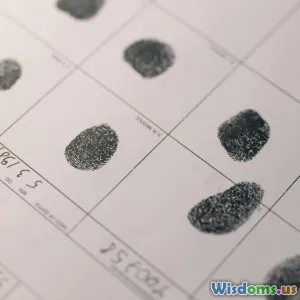
Revolutionary Tools: How They're Changing Crime Investigation
7 min read Explore how revolutionary tools like AI, DNA tech, and digital forensics are transforming crime investigation today. (0 Reviews)
Revolutionary Tools: How They're Changing Crime Investigation
Crime investigation is stepping into a new era, powered by revolutionary tools formerly confined to the realm of science fiction. The landscape of criminology has transformed dramatically with the adoption of cutting-edge technologies that enhance precision, speed, and efficiency. This article explores these transformative tools, their applications, and real-world impact on the fight against crime.
Introduction
Imagine solving complex crimes within days or even hours in scenarios that traditionally might have taken weeks or months. Behind this remarkable acceleration lie innovative investigative tools reshaping the forensic process: Artificial Intelligence (AI), advanced DNA sequencing, digital forensics platforms, and biometric technologies. These developments not only provide deeper insights into criminal patterns but also bolster the accuracy and reliability of evidence gathering. Early adoption by law enforcement agencies worldwide signals a paradigm shift in criminal justice.
Artificial Intelligence in Crime Investigation
AI-Powered Predictive Policing
AI algorithms analyze vast datasets including crime reports, social media activity, and demographic statistics to predict where crimes are most likely to occur. For example, the Los Angeles Police Department’s deployment of PredPol saw a significant reduction in residential burglaries by targeting high-risk areas. However, it sparks debates over privacy and potential biases inherent in algorithmic decision-making.
Enhancing Evidence Analysis
AI-driven systems excel at sorting through enormous amounts of multimedia evidence. Tools like facial recognition software enable investigators to identify suspects from surveillance videos quickly. Recently, AI-assisted voice recognition helped law enforcement identify perpetrators from intercepted phone calls in cases involving organized crime networks.
Case Linkage and Pattern Recognition
Machine learning platforms link seemingly unrelated cases by recognizing identical MO (modus operandi) or signature behaviors, helping to uncover serial offenses. The FBI’s Massive Data Analysis efforts employ AI to detect hidden connections across unstructured data, revealing patterns beyond human capability.
Advanced DNA Technologies
Next-Generation Sequencing (NGS)
Where traditional DNA profiling focused on specific markers, NGS decodes the entire DNA sample, allowing the identification of relatives or ethnic origins that expand investigative leads. The Golden State Killer was apprehended partly due to familial DNA matching in public genealogy databases, demonstrating NGS’s remarkable utility.
Rapid DNA Testing
Developed for on-site use, rapid DNA analyzers generate results in less than two hours, enabling real-time decisions during investigations. Military and border authorities have implemented these devices to promptly identify suspects or victims.
Touch DNA and Low-Template DNA Analysis
Ultra-sensitive techniques allow extraction of DNA from minimal biological material like skin cells left on objects, overcoming former limitations and opening new investigative avenues in cold cases and assault crimes.
Digital Forensics and Cybercrime Tools
Data Recovery and Decryption
Advanced software tools retrieve deleted data or decrypt encrypted files from smartphones, computers, or servers. In a recent ransomware case, forensic teams decrypted files without paying the ransom, thanks to breakthroughs in cryptanalysis.
Mobile Device Forensics
Given the ubiquity of smartphones, forensic experts use specialized tools to extract call logs, GPS data, messaging apps histories, and even metadata without compromising device integrity.
Blockchain Analysis
As cryptocurrencies rise, blockchain analytical tools trace illicit transactions tied to cyberattacks and money laundering, revealing complex financial networks otherwise difficult to track.
Biometric Innovations
Iris and Retina Scanning
Biometric evidence extends beyond fingerprints. Iris and retina scans provide highly reliable identification even under disguise attempts. Airports and secure facilities increasingly rely on these for rapid identification.
Behavioral Biometrics
New tools analyze patterns like typing rhythms, mouse movements, or gait to authenticate identities or detect impostors, invaluable in cybersecurity and crime prevention.
Real-World Insights and Examples
Cold Case Breakthroughs
The combination of AI-driven image enhancement and advanced DNA techniques has solved decades-old cases. For instance, the UK’s National Crime Agency solved a 40-year-old murder case using 3D facial reconstruction from skull remains plus familial DNA searching.
Rapid Crime Scene Processing
Portable forensic kits integrating DNA analyzers, AI-enabled CCTV systems, and biometric databases allow investigators to process scenes on-site quickly. This immediacy helps preserve evidence quality and speeds judicial proceedings.
Ethical and Legal Considerations
While technological advances aid justice, they raise concerns about mass surveillance, data security, and civil liberties. Transparent policies and oversight are crucial to balance effective policing with privacy rights.
Conclusion
Revolutionary investigative tools are rewriting the rules of criminology and crime scene investigation. With AI facilitating data crunching beyond human capabilities, DNA technologies providing new leads from microscopic samples, and digital tools unveiling cybercriminals, the pursuit of justice becomes increasingly sophisticated and accessible. Still, embracing these innovations requires vigilance to ethical concerns—striking harmony between technology and human judgment will define the future of crime investigation.
As these technologies continue evolving, societies worldwide stand to benefit from safer communities and more effective law enforcement outcomes. For students, professionals, and policymakers alike, understanding these tools is pivotal to shaping criminal justice's next frontier.
“The future of crime fighting hinges on collaboration between humans and smart technologies—enhancing our capacity to uncover truth, protect rights, and bring perpetrators to justice.” – Dr. Linda Harmon, Forensic Science Expert
Rate the Post
User Reviews
Popular Posts

















